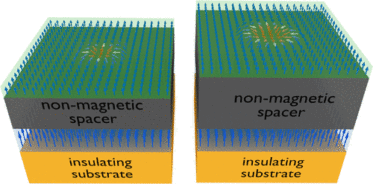
By Clarissa Bhargava
Virtually every electronic device needs memory – the ability to store and recall data. But as devices keep getting smaller and packed with more features, engineers are often tasked with not only maintaining the amount of memory available but expanding it. Since the first hard drive debuted in the 1950s, data storage density has skyrocketed more than 600-million fold. But as memory cells are made ever smaller, now only dozens of atoms wide, they are running up against fundamental physical limits. It will take some extraordinary physics to create even more high-density, low-power memory cells for the next generation of devices.
Fortunately, an extraordinary team co-led by Molecular Foundry scientists recently published a study on nanoscale magnetic structures called skyrmions that could put a new spin on tomorrow’s memory and logic devices.
Magnetic skyrmions are nanoscale quasiparticles sometimes described as tiny hurricanes of magnetization. Like hurricanes, they can “move” across a material, remaking themselves as they go while remaining stable. They are able to store information in the way that they twist their local magnetic field into a knot. Skyrmions make an exciting candidate for memory and logic devices because they can store a very high density of information, and it takes almost no power to maintain them once they’re created.
Long theorized to exist, skyrmions were only directly observed a decade ago, and at first only stabilized at very low temperatures and in the presence of large magnetic fields.
For skyrmions to be used in a wide range of devices, they need to be stable at everyday temperatures, so scientists found a way to stabilize them at or above room temperature using a technique called interface engineering. However, these early structures still needed to use an external magnetic field to form the skyrmions, which would have complicated efforts to make energy efficient skyrmion-based devices at the manufacturing scale. And, in an age where massive cloud storage data centers practically require their own power plants, low-power memory is a must.
In their new study, a research team led by UC Berkeley, the Molecular Foundry, the University of Hamburg (Germany), and the National Institute of Science Education and Research (India) successfully removed both of these complications: they created and stabilized magnetic skyrmions at room temperature, and without applying an external magnetic field.
The secret lies in an interaction called interlayer exchange coupling.
Instead of using an external magnetic field, the researchers built a layered structure containing a thick ferromagnetic layer that works as a “reference” for the ultra-thin “free” magnet where the skyrmions form, keeping them stable. Researchers inserted a non-magnetic “spacer” in-between the reference magnet and the free magnet and found that they could tune the properties of the skyrmions by adjusting the thickness of the spacer. Specifically, they found that they could adjust the size and the density of skyrmions on the free magnetic surface.

The layered structure was made using a technique called molecular beam epitaxy, a bottom-up technique to build ultra-thin structures practically atom by atom. In order to study the evolution of the skyrmions as the layers were deposited, the team observed as the magnetic state changed using the spin-polarized low energy electron microscope (SPLEEM) in the Molecular Foundry.
The discovery that these so-called “zero-field” skyrmions could be stable at room temperature and customized for differed applications makes them excellent candidates for the next revolution in magnetic memory and logic devices.
The next step will be to understand how to optimize the magnetic multilayers to make these zero-field skyrmions as small as possible, and to study their movement under the influence of an electric current. This would push zero-field magnetic skyrmions one step closer to realizing their technological potential.
These tiny whirls of magnetization may end up taking the world by storm.
Read the paper:
R. Lo Conte, A. K. Nandy, G. Chen, A. L. Fernandes Cauduro, A. Maity, C. Ophus, Z. Chen, A. T. N’Diaye, K. Liu, A. K. Schmid, R. Wiesendanger. Nano Lett. 2020, 20, 7, 4739–4747. https://doi.org/10.1021/acs.nanolett.0c00137

